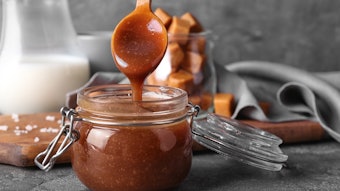
(+/-)-6-Methoxy-2,6-dimethylheptanal
Source: Bedoukian
FEMA #4745, CAS #62439-41-2
Not naturally occurring.
Odor 1%: Sweet, light, floral, pulpy, green, fruity, rindy, honeydew, fresh, crisp, watermelon bubble gum, fatty soapy.
Taste @ 1 ppm: Light, floral, pulpy, green, cucumber skin, fatty, waxy, soapy.
Taste @ 3 ppm: Green, floral, pulpy, fresh, waxy, rindy, watery, candy watermelon.
Possible Applications: This aldehyde goes by so many different names. The FEMA GRAS one, the shortened version of methoxymelonal and Bedoukian’s trade name for it: Aquaflor. All of those sort of conjure up profiles which really fit with the descriptors and subsequent profiles the panel chose. We can see this in all the melons, especially honeydew and watermelon. Other fruit profiles include dragonfruit, kiwi, raspberry, apricot, pear, apple, peach, nectarine. The green floral finish would help cilantro, bell pepper, jalapeno, and pickles and soften up the harshness of bell peppers and green chilis. It also might be a nice touch for floral profiles such as rose and citronella.
ε-Decalactone
Source: Millipore Sigma
FEMA #3613, CAS #5579-78-2
Not naturally occurring.
Odor @ 1%: Sweet, coumarinic, creamy, vanillic, slightly caraway, dill, celery, cardboard, lovage, brown, waxy, nutty, slight coconut, butter, slightly burnt caramel, smokey.
Taste @ 1 ppm: Creamy, green, dill, slight mouthfeel, coconut, mild, powdery, waxy, celery, brown earthy.
Taste @ 3 ppm: Creamy, mouth-coating, goat’s milk, waxy, celery, brown, dried leaves, butter, creamy, slightly dairy, mint, sweet, coconut, cheesy, peach fuzz finish.
Possible Applications: This is an unusual lactone with a 7-membered ring, and the panel fell into different camps here. There was the creamy, coconut, dairy, cheesy group with suggestions of caramel, maple, cooked milk, butter, peanut butter, goat’s milk and cheese, marshmallow, crème brulee and tiramisu, toasted coconut and tropical profiles. But then there was the more savory direction with thoughts of celery, dill, caraway seeds and bread, spice blends, chicken and beef. All agreed this would be a fine addition to mouthfeel flavors.
2-Phenoxyethanol
Source: Vigon
FEMA #4620, CAS #122-99-6
Naturally occurring in: Apple, avocado, cocoa, mango, pea, rice, tea.
Odor @ neat: Rich floral, dark berry, heavy, fatty, green, powdery, vanillic, mild, cinnamic, phenolic, smokey, balsamic. 2-phenoxyethanol reminded the panel of cherry blossoms.ksena32 at Adobe Stock
2-phenoxyethanol reminded the panel of cherry blossoms.ksena32 at Adobe Stock
Taste @ 0.5 ppm: Low, light floral, sweet, powdery, rose, cinnamic.
Taste @ 1 ppm: Mild floral, creamy, dairy, bitter, soapy, cinnamic, vanillic, powdery, waxy.
Possible Applications: Vigon refers to this as Rose ether and there is some directional floral aspect to this ingredient. There were some light floral notes which reminded me of actual blossoms – so think orange blossom, or cherry blossom, or a pansy profile or jasmine tea. Fruit profiles mentioned included grape, dark berry blends and black cherry, raspberry, apricot, blueberry and blackberry. Other profiles mentioned were pickle, cucumber and balsamic. Sort of late in the profile is that cinnamic aspect for use in profiles where you want to have cinnamon spice notes. Think of things like cinnamon rolls, apple spice blends or pie, chai, mulled wine, horchata, spiced whiskey and gingerbread.
Hydroxy-(4-hydroxy-3-methoxyphenyl)acetic acid
Source: Millipore Sigma
FEMA #4660, CAS #55-10-7
Not naturally occurring.
Odor @ neat: Vanillic, woody, smokey, phenolic, sweet, brown, earthy, cocoa, bourbon vanilla, creamy.
Taste @ 5 ppm: Brown, vanilla, smokey, harsh aftertaste, mild vanilla, cardboard, sweet, weak.
Taste @ 10 ppm: Weak, sweet, dark coffee, brown smokey, delayed vanilla impact.
Possible Applications: Another name for this mouthful is vanilmendalic acid. What a cool name. It is a low impact material. Certainly there are some vanillic aspects to this but also coffee and chocolate notes as well. In addition to those sweet brown profiles, the panel thought of marshmallow, caramel, toffee, dulce de leche, milk tea, root beer and smoke profiles. A few panelists found this to have a trigeminal effect. You can almost feel like you know what this will be like before even tasting it!
Galangal root oil
Source: Berjé
FEMA #32500, CAS #8024-40-6
Odor @ 1%: Earthy, dusty, brown, spicy, rooty, ginger, fruity, herbal, citrus, sweet, floral, green, black pepper, fresh, basil, animalic.
Taste @ 0.1 ppm: Earthy, rooty, dusty, brown, green, herbal, ginger, heat, black pepper, cardamom, trigeminal bite, sweet, terpenic, spicy, camphoraceous.
Taste @ 0.2 ppm: Earthy, rooty, dusty, brown, cinnamic, ginger, nutmeg, black pepper, terpenic, fresh, cardamom, basil.
Possible Applications: Lots of spices were mentioned above so those all would get lumped in this part: black pepper, ginger, cardamom, cinnamic, nutmeg/mace, Szechuan pepper, curry, turmeric and really anything needing fresh terpenic notes. And then think of all the blends which would use those things such as cola, chai and of course pizza spice blends. The earthiness would fit into root vegetables such as turnips, parsnips, carrots, radish and maybe a sweet potato. It doesn’t end there because we thought of blueberry and blackberry. There was some dissent on adding to ginger, as some panelists love ginger and didn’t want to muddy it up. I think it is worth a shot to try at least. And the one that made us all hungry: Tom Yum Soup!
γ-Jasmolactone
Source: Bedoukian
FEMA #4439, CAS #67114-38-9
Not naturally occurring.
Odor @ 1%: Creamy, dairy, buttery, oily, sweet, fruity, peach, heavy, coconut, apricot.
Taste @ 0.2 ppm: Lactonic, waxy, slightly floral, buttery, slightly fruity, peach.
Taste @ 0.5 ppm: Peach fuzz, creamy, juicy, buttery, dairy, fruity, apricot.
Possible Applications: Like some other lactones, we can slide this one into fruity and dairy camps. Peach, apricot, mango, raisin, papaya, fig, plum, strawberry and nectarine would all benefit from this. For dairy, we thought of cream cheese, cottage cheese, butter, milk and ice cream. Now, who doesn’t love that?
6-Methyl-5-hepten-2-one-propylene glycol acetal
Source: Endeavour/Treatt
FEMA #4400, CAS#68258-95-7
Odor @ 1%: Very floral, citral, plastic, green, fresh, citronella, watermelon rind, herbal, citrus, slightly woody, slightly anise-like.
Taste @ 0.2 ppm: Weak, green, floral, citrus, slightly woody finish.
Taste @ 0.5 ppm: Fruity, tropical, skin notes, slightly woody, floral, green, citrus, watermelon, rindy.
Possible Applications: Almost all comments centered around fruit and fruity profiles. I thought this might be very useful in tropical profiles such as mango, papaya, passionfruit and guava. Others thought this would be fun in watermelon, fruit punch and orange and other citrus profiles. We also thought of bell pepper and tomato. A sort of curve-ball thought I had was honey.
 The panel discussed using γ-jasmolactone in cream cheese, cottage cheese, butter, milk and ice cream applications.pilipphoto at Adobe Stock
The panel discussed using γ-jasmolactone in cream cheese, cottage cheese, butter, milk and ice cream applications.pilipphoto at Adobe Stock
4-Ethyloctanal
Source: Endeavour/Treatt
FEMA #4117, CAS #58475-04-0
Odor @ 1%: Animal fat, waxy, green fresh, vegetative, slightly rancid, gamey, dairy, fatty, herbal, plastic, lactonic, lamb, citrus, fruity.
Taste @ 0.1 ppm: Fatty, waxy, animalic, slightly fruity, mouthfeel, fatty, cheesy-aftertaste, green, rancid, very heavy / backend.
Taste @ 0.2 ppm: Fatty, waxy, animalic, mouthcoating, green earthy, mushroom gamey, creamy, butter, heavy, umami aftertaste, fatty, lactonic, dairy.
Possible Applications: Well, we sure see where this is heading don’t we? First, we want to cover all the animalic fatty aspects such as tallow, lard and butter. And then we want to mention goat, lamb, mutton, beef, chicken, pork and game. This is a relative of 4-ethyloctanoic acid so none of that is surprising. But the panel also felt that this could be a great addition to dairy profiles including butter and cheeses such as American, aged cheddar, goat cheese, Manchego and Feta. There are some citrus aspects to this aldehyde which would provide lift to fatty profiles, but I would not think this would be as helpful to citrus flavors as some other options. This is, however, a great option for mouthfeel and products which are reduced-fat. I think it would be most effective in strong profiles (coffee/chocolate/maple and many others) where the animalic notes would be hidden.










